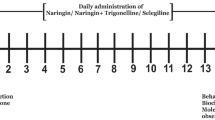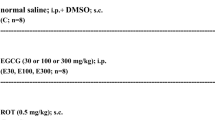Abstract
Parkinson’s disease (PD) is a neurodegenerative disorder caused by selective dopaminergic neuronal loss. Rotenone is a neurotoxin that selectively destroys dopaminergic neurons, leading to PD-like symptoms. Quercetin possesses antioxidant, anti-inflammatory, and neuroprotective properties but a major drawback is its low bioavailability. Therefore, the present study was designed to evaluate the neuroprotective effect of quercetin in combination with piperine against rotenone- and iron supplement–induced model of PD. Rotenone was administered at a dose of 1.5 mg/kg through an intraperitoneal route with iron supplement at a dose of 120 μg/g in diet from day 1 to day 28. Pre-treatment with quercetin (25 and 50 mg/kg, p.o.), piperine (2.5 mg/kg, p.o.) alone, quercetin (25 mg/kg, p.o.) in combination with piperine (2.5 mg/kg), and ropinirole (0.5 mg/kg, i.p.) was administered for 28 days 1 h prior to rotenone and iron supplement administration. All behavioral parameters were assessed on weekly basis. On the 29th day, all animals were sacrificed and striatum was isolated for biochemical (LPO, nitrite, GSH, mitochondrial complexes I and IV), neuroinflammatory (TNF-α, IL-1β, and IL-6), and neurotransmitter (dopamine, norepinephrine, serotonin, GABA, glutamate) estimation. Quercetin treatment attenuated rotenone- and iron supplement–induced motor deficits and biochemical and neurotransmitter alterations in experimental rats. However, combination of quercetin (25 mg/kg) with piperine (2.5 mg/kg) significantly enhanced its neuroprotective effect as compared with treatment with quercetin alone. The study concluded that combination of quercetin with piperine contributed to superior antioxidant, anti-inflammatory, and neuroprotective effect against rotenone- and iron supplement–induced PD in experimental rats.










Similar content being viewed by others
Abbreviations
- PD:
-
Parkinson’s disease
- Fe:
-
Iron
- QC:
-
Quercetin
- PP:
-
Piperine
- GABA:
-
gamma-Aminobutyric acid
- LPO:
-
Lipid peroxidation
- GSH:
-
Glutathione
References
Bhardwaj RK, Glaeser H, Becquemont L, Klotz U, Gupta SK, Fromm MF (2002) Piperine, a major constituent of black pepper, inhibits human P-glycoprotein and CYP3A4. J Pharmacol Exp Ther 302:645–650
Bodis-Wollner I (2003) Neuropsychological and perceptual defects in Parkinson’s disease. Parkinsonism Relat Disord 9:83–89
Dexter DT, Jenner P (2013) Parkinson disease: from pathology to molecular disease mechanisms. Free Radic Biol Med 62:132–144
Dorsey E, Constantinescu R, Thompson JP, Biglan KM, Holloway RG, Kieburtz K, Marshall FJ, Ravina BM, Schifitto G, Siderowf A, Tanner CM (2007) Projected number of people with Parkinson disease in the most populous nations, 2005 through 2030. Neurology 68(5):384–386
Ellman GL (1959) Tissue sulfhydryl groups. Arch Biochem Biophys 82:70–77
Erikson KM, Aschner M (2003) Manganese neurotoxicity and glutamate-GABA interaction. Neurochem Int 43(4-5):475–480
Green LC, Wagner DA, Glogowski J, Skipper PL, Wishnok JS, Tannenbaum SR (1982) Analysis of nitrate, nitrite, and [15N]nitrate in biological fluids. Anal Biochem 126:131–138
Gubellini P, Kachidian P (2015) Animal models of Parkinson’s disease: an updated overview. Rev Neurol 171(11):750–761
Hirsch EC, Brandel JP, Galle P, Javoy-Agid F, Agid Y (1991) Iron and aluminum increase in the substantia nigra of patients with Parkinson’s disease: an X-ray microanalysis. J Neurochem 56(2):446–451
Karunanithi K, Annadurai A, Krishnamoorthy M, Elumalai P, Manivasagam T (2011) 1-methyl 4-phenyl 1, 2, 3, 6-tetrahydropyridine is a potent neurotoxin: Gamma-tocopherol recuperate behavior, dopamine, and oxidative stress on Parkinsonic mice. Int J Nutr Pharmacol Neurol Dis 1(2):139–145
Kumar P, Kalonia H, Kumar A (2012) Possible GABAergic mechanism in the neuroprotective effect of gabapentin and lamotrigine against 3-nitropropionic acid induced neurotoxicity. Eur J Pharmacol 674(2-3):265–274
Lasley SM, Gilbert ME (2002) Rat hippocampal glutamate and GABA release exhibit biphasic effects as a function of chronic lead exposure level. Toxicol Sci 66:139–147
Lowry OH, Rosebrough NJ, Farr AL, Randall RJ (1951) Protein measurement with the Folin phenol reagent. J Biol Chem 193:265–275
Patel AB, de Graaf RA, Mason GF, Rothman DL, Shulman RG, Behar KL (2005) The contribution of GABA to glutamate/glutamine cycling and energy metabolism in the rat cortex in vivo. Proc Natl Acad Sci U S A 102:5588–5593
Radad K, Rausch WD, Gille G (2006) Rotenone induces cell death in primary dopaminergic culture by increasing ROS production and inhibiting mitochondrial respiration. Neurochem Int 49(4):379–386
Rustay NR, Wahlsten D, Crabbe JC (2003) Influence of task parameters on rotarod performance and sensitivity to ethanol in mice. Behav Brain Res 141(2):237–249
Segura-Aguilar J, Kostrzewa RM (2015) Neurotoxin mechanisms and processes relevant to Parkinson’s disease: an update. Neurotox Res 27(3):328–354
Singh S, Jamwal S, Kumar P (2017) Neuroprotective potential of quercetin in combination with piperine against 1-methyl-4-phenyl-1, 2, 3, 6-tetrahydropyridine-induced neurotoxicity. Neural Regen Res 12(7):1137–1144
Sottocasa GL, Kuylenstierna B, Ernster L, Bergstrand A (1967) An electron-transport system associated with the outer membrane of liver mitochondria a biochemical and morphological study. J Cell Biol 32:415–438
Valko M, Jomova K, Rhodes CJ, Kuča K, Musilek K (2016) Redox-and non-redox-metal-induced formation of free radicals and their role in human disease. Arch Toxicol 90(1):1–37
Wang Q, Liu Y, Zhou J (2015) Neuroinflammation in Parkinson’s disease and its potential as therapeutic target. Transl Neurodegener 4(1):19–28
Whitton PS (2007) Inflammation as a causative factor in the aetiology of Parkinson’s disease. Br J Pharmacol 150(8):963–976
Yu CA, Yu L (1967) Preparations of succinate—cytochrome c reductase and the cytochrome bc 1 particle, and reconstitution of succinate-cytochrome c reductase. Methods Enzymol 10:216–225
Yu L, Wang X, Chen H, Yan Z, Wang M, Li Y (2017) Neurochemical and behavior deficits in rats with iron and rotenone co-treatment: role of redox imbalance and neuroprotection by biochanin A. Front Neurosci 11:657–668
Zarai Z, Boujelbene E, Salem NB, Gargouri Y, Sayari A (2013) Antioxidant and antimicrobial activities of various solvent extracts, piperine and piperic acid from Piper nigrum. LWT Food Sci Technol 50(2):634–641
Zucca FA, Segura-Aguilar J, Ferrari E, Muñoz P, Paris I, Sulzer D, Sarna T, Casella L, Zecca L (2017) Interactions of iron, dopamine and neuromelanin pathways in brain aging and Parkinson’s disease. Prog Neurobiol 155:96–119
Acknowledgments
The authors are highly thankful to Mr. Parveen Garg, Chairman, ISFCP, for providing excellent research platform.
Author information
Authors and Affiliations
Corresponding author
Ethics declarations
These animals were fed with standard diet in accordance with Institutional Animal Ethics Committee (IAEC) guidelines. The experimental protocol was reviewed and approved by the Institutional Animal Ethics Committee (ISFCP/IAEC/CPCSEA/2018/382) and performed in accordance with Indian National Science Academy (INSA) and Committee for the Purpose of Control and Supervision of Experiments on Animals (CPCSEA) for the use and care of experimental animals.
Conflict of Interest
The authors declare that they have no conflict of interest.
Additional information
Publisher’s Note
Springer Nature remains neutral with regard to jurisdictional claims in published maps and institutional affiliations.
Rights and permissions
About this article
Cite this article
Sharma, S., Raj, K. & Singh, S. Neuroprotective Effect of Quercetin in Combination with Piperine Against Rotenone- and Iron Supplement–Induced Parkinson’s Disease in Experimental Rats. Neurotox Res 37, 198–209 (2020). https://doi.org/10.1007/s12640-019-00120-z
Received:
Revised:
Accepted:
Published:
Issue Date:
DOI: https://doi.org/10.1007/s12640-019-00120-z




